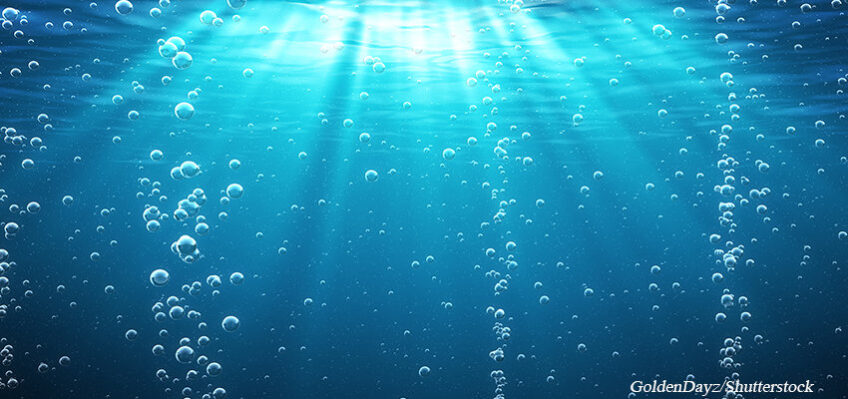Evolutionists assure us all life, just as we know it today, evolved ever so gradually. But if it did, how? Here is a baffling creature for evolutionists to gasp over –– the ugly Lungfish. He’s a fish, and yet he breathes air into a set of perfect lungs, and more than that… he estivates! Read how this strange-breathing creature fogs up evolutionists’ glasses!
A lone African probed intently in the dry, cracked mud of the empty lake bed. Stopping suddenly, he grinned hugely, showing white, gleaming teeth. He began digging carefully, removing surrounding mud from a lumpy clod of earth. He places it in the hide bag at his side, and, whistling cheerfully, begins the long walk back to the village. He would eat well tonight, he thought as he felt the weight of the four blobs of drying, caked mud in his bag.
Whaaat? An African native eating mud? No. Lungfish.
These strange creatures look somewhat like an eel, and spend their lives in the lakes and mud flats of South America and Africa. They have the remarkable ability to estivate — that is, to lie dormant, for months and even years at a time in dry mud, waiting for the next rainy season to again fill their shallow lake with water. They are sought by natives, dug from their muddy cocoons, and eaten as a great delicacy.
There is also one species of lungfish in Australia, but it cannot estivate. But how could these other five species of lungfish “gradually acquire” such a fantastic ability? How did a fish ever contrive to grow a pair of lungs?
The questions this strange creature evokes breathe a few shadows of doubt over the theories of evolutionists.
The Air-Breathing Fish
Air-breathing fish are not very common. But there are five living species of fish that do it. They’re the lungfish of South America and Africa, ranging in size from one recorded giant of six feet in length, and weighing one hundred pounds, to others with maximum sizes of about 2 ½ feet.
They’re strange-appearing creatures, with strange habits. The strangest of all is that they “estivate,” which is a long, dormant sort of “hibernation,” except different and more extreme. It is claimed by evolutionists that these fish gradually grew a set of lungs, and gradually acquired the ability to lie dormant in dry ground, for months at a time.
Notice! “Lungfishes belong to the ancient order of the dipnoans — fishes with both gills and lungs. They date back…to the middle of the Devonian, when ponds and streams began to dry up and many fishes died.
“The lungfishes were not only able to breathe air, but to travel from mud puddle to mud puddle on paddlelike fins. Eventually they acquired the ability to lie dormant in the mud, where they waited for the seasonal rains” (The Fishes, F.D. Ommanney and the Editors of Life, p. 77, emphasis mine throughout).
But how do such remarkable abilities — such intricate designs — just “evolve” gradually? Again I ask, if our minds are the end product of what evolution insists is a logical process, then shouldn’t our logical minds be able to understand, quite easily, the process by which they came into being? Let’s ask a few logical questions, then, about the lungfish.
What’s Simple About Breathing?
Ever study into lungs? Most people never have. Most don’t know much about their own breathing process — and very few try to develop better lungs and breathing habits. We take breathing for granted, until we’re deprived of air!
Almost daily, we might exclaim, “I’m smothering in here — son, open the window!” or, “This room is stifling, and I can hardly breathe, let’s get some air in here!” But most of the time we take breathing pretty much for granted. Witness the millions who daily pollute their lungs with tars, nicotine, bits of burnt paper, and other waste material…
There’s nothing simple about lungs, and breathing. First, breathing is a combination of voluntary action and INvoluntary action. Most of the time, you’re not really “conscious” of the fact you’re breathing. But, whenever you must, as in swimming, or other activity — you can hold your breath — sometimes even up to a minute or more. But much longer than that, and, unless you’re a trained pearl diver, you will die!
How could such a marvelous mechanism as the lung, with its millions of tiny globules of thin membrane, or “air sacs,” with the labyrinth of air tubes, sensory nerves, interlocking arteries and blood vessels, bronchial tubes, esophagus, and the like, develop GRADUALLY?
Are there any half-lungs or half-gills around today? Are there any partly functional lungs, and partly functional gills? Let’s dwell on that just a moment.
Evolutionists enjoy asserting their processes cannot be observed in action, because they require such infinite lengths of time. They speculate various human organs, such as the appendix, or tonsils, are “carryovers” from some remote time, and are ever so subtly and gradually on their way out today.
They use prodigious amounts of time to dodge behind when asked why we can’t see evolution in action. But let’s use some of the logic that appeals to our minds.
No Intermediate Species
Remember, there are no such things as imperfect, or only half-efficient lungs today! No lungfish has a part gill, or one that is functioning imperfectly.
Every creature, whether breathing through lungs, wherever located, and however shaped or arranged; whether “absorbing” through skin, or producing through gills, must exist on oxygen. Somehow, by whatever means, they must “breathe.”
There is no such thing as an imperfect, partly developed, halfway method of receiving that oxygen supply. Each creature, in order to survive, even moments, or minutes, or hours, must continually recharge his supply of life-giving oxygen!
Think again. If evolution could possibly be true, then where are the millions upon millions of transitional creatures, all of which would be at various steps in the imaginary evolutionary “trees,” only part this, or part that? Where is there such a thing as a part feather, part scale? Where is a part gill? Or a part lung? Missing!
There is no such thing as an imperfect, or partly formed, or inadequate, gill. Either it produces air for the fish, and the fish survives, or it does not. If it does not, then the fish never existed. If it does, then the fish existed and survived, whatever the span of time that survival took.
And, supposing (which is not true) there was such a thing as an imperfect breathing apparatus — and the fish could only live for a certain number of hours or days — which would be easier? To develop better gills? To develop lungs? Still better, why not “gradually” develop a much shorter life cycle; mate, spawn, and die all within a few hours and let the eggs become entrapped in the mud, and hatch when the rains begin once again.
But none of these occur. Yet, in each case, if evolution could possibly be true any of these would be far easier than the guesswork evolution advances about the lungfish.
Any such development (which is impossible) would have to occur immediately — on the split second — on the instant, or the fish perished. If so, then they were surviving. And if they were surviving, and passing along the same characteristics for survival to their offspring, then their offspring would look just like they did, and would be surviving in the same way, and there was NO NEED to change it.
Confusing, isn’t it? There are no such creatures living today — nor is there a shred of proof in the prodigious evidence from fossil life that any such creatures ever lived! But think further. If evolution has a gasp of a chance to be true, there would have to be far more of those halfway creatures than the “more advanced” ones!
If there were such a thing as evolution, then we should have to observe, somewhere in the world today, an august body of men whose duty it was to “decide” who may belong to the human family, and who must remain in the trees! There would be thousands of creatures who would be part this, and part that. They would be even more bizarre, weird, and ugly, in most cases, than some of the creatures that do exist today. But no such creatures exist. Nor did they, ever.
Again, remember — if the “intermediate” species (which are missing in the fossil record) are missing because they were not so well “equipped to survive” then it would naturally follow there would be far more of such creatures in the fossils than the “equipped” or “fully developed” ones. Why? Simply because if they were not equipped to survive, they all died. And if they all died, there would be billions and billions of them, because there had to be enormously more intermediate stages than the “final” or “well-developed” ones.
Therefore, the fossil record would be reversed! Instead of perfectly formed fossils, looking, in most cases, exactly like life on earth today, and no intermediate species, the fossils would abound with “intermediate” species; half this and half that, and would be almost vacant of the “developed species.” As a matter of fact, scientists would be bedazzled, confused, and bewildered in trying to categorize such creatures, and would not know which would be the “terminal” or “complex” and which would be the “simple.”
Remember, to live at all, is to survive! Whether a tiny insect, surviving for only moments or hours along a stream or lake, and then falling into the water, its brief life cycle finished, or a slithery lizard, lazing in the sun for nearly a millennium, living — for whatever brief or longer span of time — is surviving!
One of the most obvious, simple, and shockingly damaging evidences against evolutionary thought is the total absence of intermediate species — living or dead. But let’s go back to the lungfish, and the quote you read from an author concerning his remarkable ability.
If He Did — HOW DID HE?
Remember, we read, “The lungfishes were not only able to breathe air, but to travel from mud puddle to mud puddle on paddlelike fins. Eventually they acquired the ability to lie dormant in the mud, where they waited for the seasonal rains.” But how did the ancestors of lungfish first become able to “breathe air?”
Evolutionists tell us they simply began to “gulp air.” The air they swallowed — we are expected to swallow — passed through the intestinal tract and was regurgitated. Or the air may have simply been gulped so that oxygen would be absorbed through the moist skin in the mouth and throat. Later, these pre-lungfish developed this new breathing idea into “lungs.”
But that isn’t the end of this fishy story. Some of these fish with lungs, we are told, were the ancestors of birds and mammals by way of the amphibians and reptiles. And for those that decided to remain in water, this “lung” became an air float by which fishes improved their swimming.
One author, realizing the fanciful ring to these notions, apologetically exclaimed, “Even if we could have been on the scene when the fishes developed lungs, we could scarcely have predicted the ultimate significance of the invention” (The Fishes, Url Lanham, page 32).
Proof for this? None, of course. But we are assured, lungfishes were “able to breathe air.” That’s remarkable. So am I. As a matter of fact, I was born with a perfect set of lungs, and, though I don’t remember it, began breathing from birth. I’ve been doing it ever since. I hope to continue for a long time — so long as oxygen is my life’s source. But, when you read quickly a sketchy account of how this or that is supposed to have “occurred” in the evolutionary scheme of things, you just sort of pass over quickly some mighty important points. In scholarly “words” it all sounds almost appealing. But when you really focus on the problem, and ask a few logical questions, it’s a different matter.
To be able to breathe is a miraculous, fantastic, incredible, intricate, perfectly designed, thought-out, planned, created process. It is a marvel! To simply toss aside in one brief thought that a fish was “able to breathe” is entirely too simple for the truly marvelous process of breathing. There is no explanation of how the lungfish came to possess his breathing capacity. Nor could there ever be, in evolution.
But this is only the beginning of the problem. We are assured this strange creature was able to travel — over land, from mud puddle to mud puddle on paddlelike fins. All right, how was he?
How did he locate the next puddle? Did he have some built-in navigational equipment? Did he have super smell? How was he able to tell the next puddle was going to be deeper than the one he left, and therefore would last longer?
And why travel, anyway? If he is able to estivate, which he is, then when his own puddle began going dry, he would simply estivate, and not bother dragging his tail a mile or two over sticks, rocks, moss, dirt, leaves, snakes, and all other objects, to the next puddle, would he? And why expose himself to every sort of predator? Here he is, dragging himself along over dry land — in search of another puddle.
But, to really create the story, let’s try to imagine the trip of the very first lungfish in all history. Remember, if lungfish evolved, then somewhere, sometime, there had to be that very first excursion from puddle to puddle — that very first breathing spell. That very first attempt at estivation.
Introducing “Gaspy”
So again, let’s go back — WAY, way, way back in time, to the saga of the first puddle-hopping trip. Here he is — breathing in racking sobs. He’s a slithery, long, muddy, air-breathing fish, wriggling feebly in a gooey, slimy mud bog. He knows his skin will soon dry out. (Please don’t keep asking embarrassing questions through this story, like, “But how did he first begin breathing?” or, “But why not just estivate where he was?” or, “Why not just dry out, and stay on land?” Because you’ll only confuse the story!)
So Gaspy rears his head a full inch and a half, and begins his wearisome journey. He’s headed for a deeper puddle. So he paddles, struggles, wriggles to the thickest mud, and begins slowly clawing, er, finning, his way across the cracking edge of the mud bog, onto the dry ground, and across the forbidding terrain.
Have you ever seen what a dry, desert-like environment looks like from about one half inch above it? Even a small twig can be a forbidding obstacle! One to take even a big lungfish’s breath! But he crawls along.
How far to go? Which direction to head? How does he know there will be greener pastures, er, wetter water, ahead somewhere? Why does he get the urge to go in the first place? Please! No more questions!
Overhead, a few hours later, an evil shape swirls down, down, in ever narrowing spirals. How about that! There, stretched out on the sand, miles from nowhere — having departed the only dependable mud bog in twenty miles, lies Gaspy! The buzzard lands — and begins his meal.
So none of the original lungfishes survive. Out of their bog, crawling around on land, some are eaten by predators. Others get lost, and struggle along into the desert, finally drying out completely, and dying of extreme exposure and dehydration. Others return to the bog they left — only to find it dried out, and too hard to burrow into, and, too late to estivate, they die on the bog shore.
Still others decide NOT to go looking for wetter water — but to stay where they are! But, forsooth (or gasp, maybe?), they haven’t yet evolved the remarkable ability to estivate. And when the water is all gone, they die!
So, exit Gaspy, who never existed anyway. You see, the creatures could NOT have known there would ever be another rainy season, anyway! Because if they first existed in such a climate, when yearly patterns were pretty much like they are now, then they had to be doing exactly as they’re doing now or they didn’t survive!
But if they lived in an extremely wet area, without seasonal drying, and seasonal monsoons, then they would have to have developed the ability to estivate, or to survive the dry seasons when the very first one came along.
That means, in a matter of days or weeks. Did they? Evolution answers this would be impossible! Then did some weird mutation occur? Did some ancient lungfish just happen to give birth to a little one that loved the mud? Did he pass this on to his descendants? Then why didn’t they just go ashore, and stay there? Why didn’t they just evolve into a snake, or a lizard — and live under a rock?
No — the word “eventually” will not fit when it comes to “acquiring the ability” to lie dormant in the mud, and wait for another rainy season. But this is really only a part of the many problems evolutionists have with Gaspy!
Perfectly Equipped to Do What He’s Doing
You see, the lungfish is perfectly designed for his specific job in his own environment. Let’s take one of the African lungfish species for example. When the dry seasons come to the Congo basin, or the Gambia river, or the equatorial rivers of East Africa, the fish squirms into the ooze nose-first, and then turns back upward, so his nose can be just below the surface and close enough to breathe, now and then.
But the lake gradually sinks in level, the fish keeps squirming further down into the thickening mud, until his repeated surfacing for a breath creates a sort of cavity, or little air bubble in the mud, which, as it hardens, is kept open on top by the fish’s wriggling and breathing.
As the water drys up completely, the fish can continue to breathe through a little blow hole at the top of the bulb-like cavity, without moving. Meanwhile, it has curled in such a way as to cover its delicate eyes with its slimy tail, with only its nose peeking out. Its body has been specially equipped with a slimy, gooey secretion, like mucous. As the muddy cocoon dries, this slime hardens into a parchment-like, waterproof cocoon that completely encases the body, so that the only opening remaining is a short little funnel where the fish is breathing.
But the lungfish, though he breathes, and estivates in remarkable fashion, is NOT an ordinary “air-breathing mammal.” If unwrapped from his parchment-like covering and his muddy cocoon, he will die within only hours.
During his estivation period, the fish lives off his own fat! His whole body metabolism slows down to a near standstill, with his breathing rate becoming slower and slower. Believe it or not, he may take only one breath every few hours in the deepest part of his estivation period. His little heart slows down to three beats a minute!
Now, in an arid, dry, cracked lake bed, this strange creature is able to remain safely ensconced in his parchment wrapping for up to seven long years. Eventually, the rains come. And, with the rains, the lake bed fills with water. As the water first drains into the blowhole, and fills the bulbous air pocket, the fish is unable to breathe.
The sudden cutting off of his oxygen supply causes him to awaken, and make convulsive efforts to free himself. The tail uncurls from the head, and the fish struggles upward. As the water immediately softens the top of his delicate blowhole, and the fish is now smaller than the size of his original cavity after the long fast, he immediately swims to the surface for air, and then goes about his search for tiny plant and insect life in his lake once again.
And all this evolved? Ridiculous! Impossible! No, like any creature you could study, from the tiny gnat to the huge sperm whale, the lungfish is perfectly designed to do exactly as he is doing — designed for a specific environment, a particular place in the delicate balance in what man likes to call “nature.”
This strange creature is only one more example among millions of the fantastic thought, the painstaking design, the incredible intricacy, and inter-dependability that goes into every living creature! There exists a great DESIGNER. A Great LIFEGIVER. A Great CREATOR. He is God — Your God!
And He says: “Because that which may be known of God is manifest in them; for God hath shewed it unto them. For the invisible things of him from the creation of the world are clearly seen, being understood by the things that are made, even his eternal power and Godhead; so that they are without excuse”! (Romans 1:19-20.) That means by looking at what has been created, what has been designed, what lives all around you.
God holds out solid evidence of His existence! He says you can prove He exists — not only by the breathtaking marvels all around you in this complex world, but by the fulfilled prophecies of His word! It’s time you began to talk to that God, and find Him in this world of political assassination, sickness, poverty, riot and war. It’s time you got on your knees, and worshiped, in awe and love, your own Designer, Life-giver and Creator!










